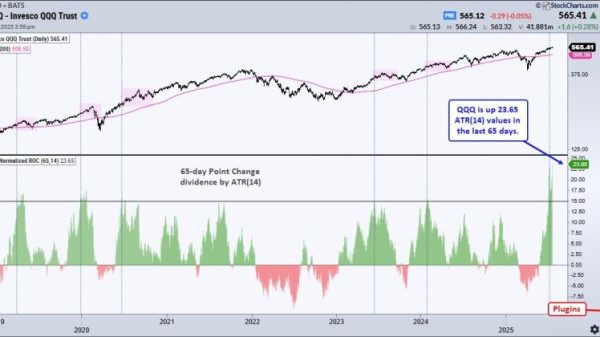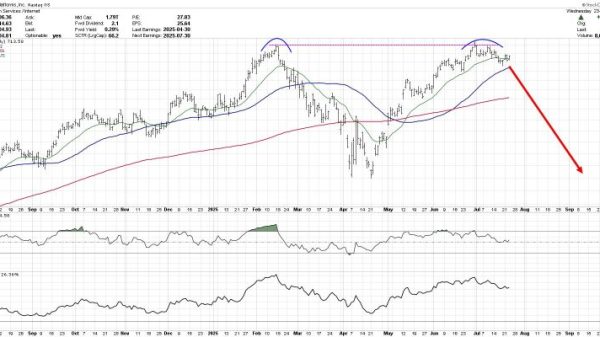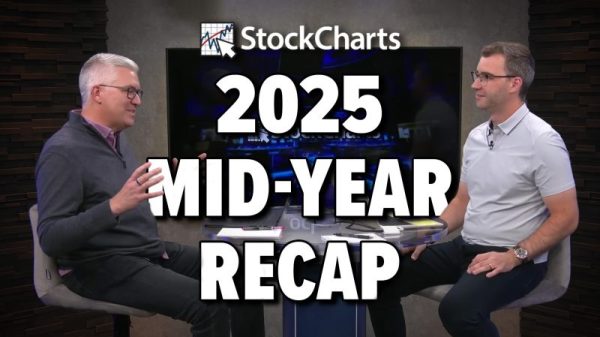The third quarter proved to be a turbulent period for the artificial intelligence (AI) sector.
It was marked by shifting investment strategies, heightened sensitivity to macroeconomic trends and significant funding injections as the US government aimed to bolster domestic chip production.
With hardware companies generally outperforming their cloud-focused counterparts, concerns are growing about over-concentration and the long-term profitability of AI investments.
Mixed performance from AI stocks in Q3
Amid a wave of quarterly reports from the tech sector, AI stocks experienced volatility, with investors reacting to both promising advancements and lingering uncertainties about the rapidly evolving industry.
This volatility was particularly pronounced in the case of NVIDIA (NASDAQ:NVDA), a bellwether for the entire AI sector. As a dominant player in the AI chip market, NVIDIA’s share price movements reverberated throughout the tech landscape. The company’s Q2 earnings report on August 28 led to a drop in its share price as investors became worried by signs of slowing growth; its quarterly revenue growth was 15 percent, compared to 18 percent in Q1.
After the release of NVIDIA’s report, Microsoft (NASDAQ:MSFT), Qualcomm (NASDAQ:QCOM) and Dell Technologies (NYSE:DELL) saw their share prices fall as well. NVIDIA shares were on the decline again on September 3 after reports surfaced that the US Department of Justice had sent subpoenas to the company and other firms — the government agency was looking for evidence that NVIDIA violated antitrust laws.
While stock market concentration can result in slower economic growth, Nicholas Mersch, associate portfolio manager at Purpose Investments, wrote in July that the attention toward semiconductor companies is justified.
“Value should be ascribed to those companies that are the most productive in the marketplace,” he said.
Quarterly earnings from chip companies like electronics manufacturer Foxconn Technology (TPE:2354), semiconductor manufacturer Micron Technology (NASDAQ:MU), and chip designers Advanced Micro Devices (NASDAQ:AMD) and NVIDIA beat analysts’ revenue expectations for the third quarter.
Demand for AI chips was cited as the main driver of growth, as was the case when Samsung Electronics (KRX:005930) reported its fastest sales and profit growth since 2021 for the June quarter.
However, results from companies like Arm Holdings (NASDAQ:ARM) and Qualcomm were less inspiring. While these companies reported impressive revenue growth, their earnings outlooks didn’t meet expectations and paled in comparison to giants like NVIDIA, which is forecasting revenue above US$30 billion for Q3.
This disparity in investor sentiment likely stems from several factors. For example, Arm Holdings, despite its crucial role in mobile chip architecture, hasn’t capitalized on the AI boom the way companies like NVIDIA and Broadcom (NASDAQ:AVGO), with large and diverse customer bases, have been able to. Meanwhile, Qualcomm’s growth prospects have been hindered by a slowdown in the smartphone market, where it faces significant challenges.
The contrast between chip stocks and cloud providers was also evident in the market’s reaction to quarterly reports from Alphabet (NASDAQ:GOOGL) and Microsoft. Alphabet surpassed estimates in Q2, but received a muted response from investors, while Microsoft’s share price dipped by 3 percent due to concerns about declining cloud growth.
AI powerhouses lay out future plans
As AI continues to gain traction, partnerships are emerging as a way for companies to keep moving.
Heading into Q3, NVIDIA CEO Jensen Huang laid out the company’s strategy to maintain its dominant position, saying it will focus on expanding partnerships with computer makers and cloud providers.
The importance of strategic partnerships has been further underscored by the success of other industry giants. Microsoft’s success in the AI boom — and certainly its performance in Q3 — can be partially attributed to its business relationships, particularly its early partnership with OpenAI.
Likewise, IBM’s (NYSE:IBM) strategic cultivation of affiliations and software offerings, evidenced by its growing AI book of business, fueled a 4.3 percent increase in its share price in July and a 2.2 percent increase in September.
Apple, which is known for its closed ecosystem, has pursued fewer partnerships than its peers, potentially limiting its future growth in the AI sector. However, the company’s recent partnership with OpenAI, geared at integrating ChatGPT into the newest iPhone, hints at a potential shift in its strategy.
While collaborations and other work fueled success for many AI players in Q3, Intel (NASDAQ:INTC) faced significant headwinds, despite its history as a leader in the tech industry. The company lowered its Q3 revenue forecast and announced a 15 percent labor cut alongside suspended dividend payments to fund its chip-making efforts.
Investors sent its share price down 31.74 percent between August 1 and August 5 in response. Intel lost even more ground a month later, when its advanced silicon wafer manufacturing process, Intel 18A, failed chip-making tests conducted by Broadcom. As of mid-October, the company was down about 50 percent year-to-date.
Intel CEO Pat Gelsinger presented investors with a plan to improve the company’s financial situation in September, including plans to establish its Foundry business as an independent subsidiary and a new partnership with Amazon Web Services to produce AI fabric chips using Intel 18A. The company has also reportedly been approached with acquisition offers from Qualcomm and Apollo Global Management, although no deal has been confirmed.
Will AI be profitable in the long term?
As mentioned, while some AI companies thrived during the third quarter, concerns persist among investors about the sector’s long-term profitability. A prime example of this dynamic emerged just one day after Taiwan Semiconductor Manufacturing Company (NYSE:TSM) posted its results for the second quarter on July 18.
A tech selloff ensued as investors, perhaps motivated by profit taking ahead of an anticipated interest rate cut, rotated out of mega-cap tech stocks and into small-caps and other sectors.
This selloff, while potentially driven by short-term strategies, demonstrated how sensitive the AI sector remains to external factors and broader market trends. “We’re concerned about the plunges of the Nasdaq and chip stocks. It’s not just a short-term thing, which we see could consolidate downwards for the next two to three months,” Allen Huang, vice president at Taipei’s Mega International Investment Services, told Reuters at the time.
An August 5 rout that wiped out about US$1 trillion in market capitalization from tech’s mega-cap companies also underscored the AI sector’s sensitivity to macroeconomic events.
However, as Fortune’s Geoff Colvin later pointed out, “most of the major names in the chip-manufacturing industry (not companies like NVIDIA that design chips but don’t make them) defied the panic and rose.”
This is not to say that chip stocks are immune from external market risks. The potential for product delays and supply shortages introduces another layer of complexity for investors assessing the long-term viability of AI.
Reports of potential design flaws in NVIDIA’s Blackwell chip series surfaced in early August, raising concerns about the delays that could impact major companies like Google, Meta (NASDAQ:META) and Microsoft. All three of these companies have heavily invested in NVIDIA to help build out their AI infrastructure.
Tech companies are allocating a significant portion of their AI spending to data center construction. These buildouts, and indeed the sheer amount of energy AI consumes, have drawn criticism from environmental groups.
Even tech companies have been vocal about the need for an energy breakthrough to power the AI buildout, reigniting talks of using nuclear energy. To that end, in September Microsoft signed a 20 year power purchase agreement with Constellation Energy (NASDAQ:CEG) to revive Three Mile Island (TMI) Unit 1.
With that in mind, some analysts have suggested that overlooked utilites stocks might be a good alternative investment, offering a less volatile way for investors to gain exposure to the AI boom.
As Fortune’s Leo Schwartz said in August, ‘AI is the new gold, but you can’t mine it without energy. And that could offer an edge to retail investors eager to buy into the trend.”
Investor takeaway
Looking head to the fourth quarter, expectations for the AI sector remain high. In its mid-year outlook, BlackRock points to data center buildouts as one of five forces that will stimulate investment in Q4.
“We see two scenarios where equities can do well: one with a concentrated group of winners in AI, even with a tough macro backdrop, and another where AI-driven growth becomes more broad-based, leading to productivity gains and sharp rate cuts,” said the firm, before emphasizing the impact of macroeconomic factors.
“The two hard economic landing scenarios differ on whether central banks can come to the rescue with rate cuts,’ it continues. A fifth scenario involves subdued growth, sticky inflation and higher rates.
The persistent threat of inflation and recession has weighed on markets all year. Investors will be closely monitoring the US Federal Reserve’s signals on potential interest rate cuts as it gears up to meet in November.
Securities Disclosure: I, Meagen Seatter, hold no direct investment interest in any company mentioned in this article.


























